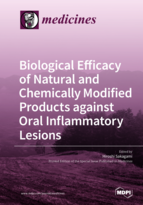Biological Efficacy of Natural and Chemically Modified Products against Oral Inflammatory Lesions
A special issue of Medicines (ISSN 2305-6320). This special issue belongs to the section "Oral Medicine and Dentistry".
Deadline for manuscript submissions: closed (31 October 2018) | Viewed by 53150
Special Issue Editor
Interests: informatics; information network; pharmacy; biological pharmacy; basic medicine; general pharmacology; boundary medicine; laboratory medicine; dentistry
Special Issues, Collections and Topics in MDPI journals
Special Issue Information
Dear Colleagues,
Oral inflammatory diseases including stomatitis (such as apthalae and glossitis), periodontitis, gingivititis and pulpitis are asociated with pain. The first line of therapy for relieaf from these deseases is the topical application of corticosteroids that reduce the inflammation and modulate the immune response. However, steroids have serious immunosuppressive action, and therefore cannot be recommended for infection-derived diseases. There are numerous natural products that show excellent anti-inflammatory, analgesic, anti-oxidative, antibacterial and antiviral actitivies. This Special Issue of Medicines focuses on the therapeutic potential of traditional herbal medicines and nutrients, plant extracts, purified and chemically modified compounds against oral inflammatory lesions; the elucidation of action mechanisms, and clinical application.
This issue invites original research contributions, as well as review articles, related to the search for anti-inflammatory, analgesic, antibacterial or antiviral substances; isolation and determination of the chemical structure of the active principle; the action mechanism in cell culture and animal experiments; clinical effects; food science.
We look forward to receiving your contributions to this Special Issue.
Prof. Dr. Hiroshi Sakagami
Guest Editor
Manuscript Submission Information
Manuscripts should be submitted online at www.mdpi.com by registering and logging in to this website. Once you are registered, click here to go to the submission form. Manuscripts can be submitted until the deadline. All submissions that pass pre-check are peer-reviewed. Accepted papers will be published continuously in the journal (as soon as accepted) and will be listed together on the special issue website. Research articles, review articles as well as short communications are invited. For planned papers, a title and short abstract (about 100 words) can be sent to the Editorial Office for announcement on this website.
Submitted manuscripts should not have been published previously, nor be under consideration for publication elsewhere (except conference proceedings papers). All manuscripts are thoroughly refereed through a single-blind peer-review process. A guide for authors and other relevant information for submission of manuscripts is available on the Instructions for Authors page. Medicines is an international peer-reviewed open access monthly journal published by MDPI.
Please visit the Instructions for Authors page before submitting a manuscript. The Article Processing Charge (APC) for publication in this open access journal is 1400 CHF (Swiss Francs). Submitted papers should be well formatted and use good English. Authors may use MDPI's English editing service prior to publication or during author revisions.
Keywords
- natural and chemically modified products
- oral inflammatory diseases
- antioxidant
- bacteria
- virus
- in vitro experiment
- animal experiment
- clinical data
- food science





